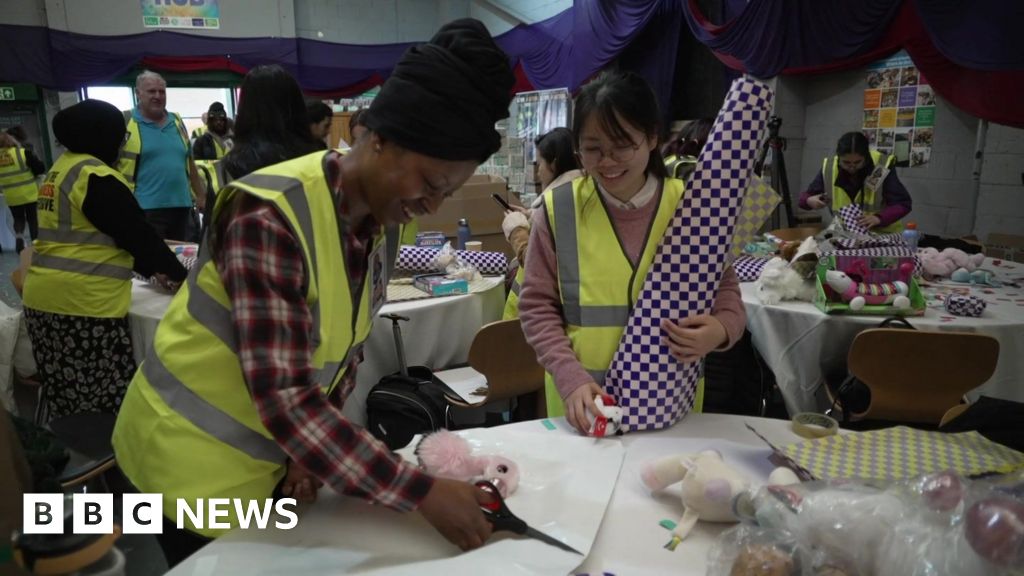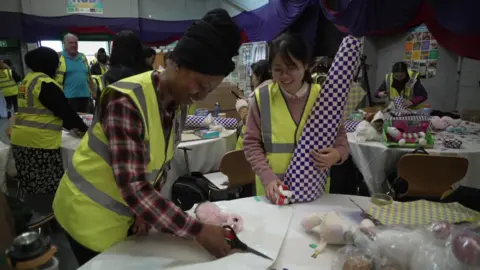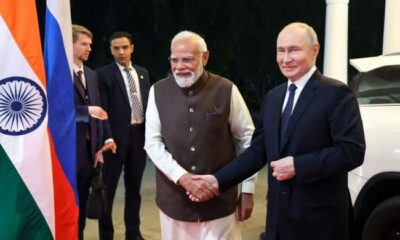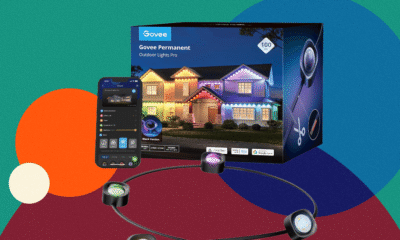Business
With two months to Christmas, here’s what retail leaders expect for holiday shopping

There’s just two months until Christmas Eve, and retailers are meeting a more cautious shopper with earlier offerings.
Most retailers won’t report third-quarter results or updated holiday expectations until just before Thanksgiving, largely considered the sector’s most important week of the year. By then, many shoppers will have already started checking off holiday shopping lists.
Amazon’s October Prime Day sales event and competitors’ ever-earlier Black Friday deals grab some portion of the holiday wallet share. The unofficial kickoff to the holiday shopping season comes as executives point to a bifurcation in consumer spending, with lower-income consumers feeling the strain on their budgets, and as a government shutdown and tariff costs threaten purchasing power.
Kohl’s is among the retailers chasing holiday shopping early with hopes of boosting the total haul.
“We want to make sure we’re driving that early consideration knowing that they’re shopping early,” Kohl’s Chief Marketing Officer Christie Raymond said at a media event earlier this month.
The off-mall department store is starting its holiday marketing campaign next week, a week earlier than last year, when it waited until after the election. In the coming days it will be breaking out the rest of the holiday merchandise not already set out in stores.
A key part of Kohl’s holiday strategy is to capture shoppers not only early, but often.
Raymond said during the last holiday season, between November and January, shoppers made “15 plus trips” on average to stores across the industry, but checked out with smaller baskets. Those findings were based on a survey that Kohl’s conducted with a third-party research firm.
“[Consumers are] doing the work to get what they want at the price they want to pay,” she said.
While Academy Sports and Outdoors CEO Steve Lawrence agreed that shoppers are savvy when it comes to price monitoring, he said he expects customers “to aggregate their spending around those key shopping moments on the calendar where they know they can get the best deals.”
Both Kohl’s and Academy Sports cater largely to a middle-income shopper. Still, Lawrence said consumers are paying close attention to discount events.
“If we run the same promotion this year that we ran last year, there’s higher take rate on it,” he said. “I think that’s a sign customers are really savvy, and they’re figuring out when it’s the right time to shop.”
Shifting shopping habits
Lawrence said that while promotions are part of every holiday season’s playbook, Academy Sports will be tweaking how it runs discounts this year in light of higher engagement with the deals.
“If last year we ran a promotion for 10 days, maybe I only run it for 4 days over the Thanksgiving weekend,” he said. “Maybe instead of having a whole brand promoted, maybe it’s only the key categories within that brand, right? Or maybe in some cases, it might be promoting at a slightly lower discount.”
Raymond said Kohl’s is seeing shoppers reaching for lower-price options and expects that to continue during the holiday season.
“Customers maybe were purchasing a premium brand, but we are seeing them trading down to private brands,” she said. “We think we’re in actually a great position to capitalize on that.”
A private brand is one made for and sold by only one retailer, allowing for more control over design and, importantly, cost. That can mean lower prices for shoppers and higher margins for the retailer than a national brand.
Shoppers carry Macy’s and Nordstrom bags at Broadway Plaza in Walnut Creek, California, US, on Monday, Dec. 16, 2024. The Bureau of Economic Analysis is scheduled to release personal spending figures on December 20.
David Paul Morris | Bloomberg | Getty Images
While Kohl’s doesn’t disclose the proportion of its sales that are private label, Chief Merchandising Officer Nick Jones said it’s not as high as it used to be, adding there’s opportunity to boost that share this holiday season, particularly for shoppers trying to stretch their wallets.
About 23% of Academy Sports business is private label, the company has said.
“In a lot of cases, [our private label] is our best expression of value,” Lawrence said. “Our goal is to be at or better than the best price on a given day.”
However, Lawrence said, innovation has to continue to inspire sales.
‘Cautiously optimistic’
The retail industry has repeatedly described its customer in recent quarters as “choiceful,” to indicate thoughtful spending, but also “resilient.” Executives continue to use those descriptors, or synonyms for them, for the upcoming holiday season.
“I think certainly with inflation in certain categories, it’s put some pressure on spending power,” Lawrence said. “But you know, what we’ve also seen is customers are very resilient. They do come out during the key shopping time periods. They came out for Mother’s Day, Father’s Day, back-to-school. We expect they’re going to come out again for holiday.”
Dick’s Sporting Goods Executive Chairman Ed Stack told CNBC this week he thought the consumer was “a little bit stressed” this season, but that he’s “cautiously optimistic.”
“If you’re going to provide value to the consumer, and they can see that, feel that value — and I’m not talking about from a price standpoint, could be innovation … then they are going to come and they are going to buy,” Stack said.
Executives for all three retailers agree inventory positions for holiday will be normal, despite tariff uncertainty that many feared would affect order volumes. None of the three were expecting merchandise shortages.
“I don’t think [inventory availability] is going to be any different than it has been in the past,” Stack said. “That really super hot item that everybody wants? That’s probably going to be in short supply, like it is every year.”
Business
Home loan EMIs to get cheaper? SBI passes on RBI’s 25 bps repo rate cut benefits; check the new rates – The Times of India

After the Reserve Bank of India (RBI) reduced the repo rate by 25 basis points last week, several major banks have moved to pass on the benefit to borrowers. Latest addition to the wave is the State Bank of India (SBI), which announced cuts across its lending rate benchmarks, in a move aimed at easing borrowing costs and lowering EMIs for both retail and corporate customers.The public sector entity slashed the MCLR, EBLR and RLLR rates and revised the BPLR and base rates, according to ET.Herre are the new rates:
MCLR rates revised across tenors
SBI has cut its Marginal Cost of Funds-based Lending Rate (MCLR) across these tenors:Short-span
- Overnight and one-month MCLR: Reduced from 7.90% to 7.85% each.
- Three-month MCLR: Cut from 8.30% to 8.25%
- Six-month MCLR: Now at 8.60%, down from 8.65%
Long-term
- One-year MCLR: Lowered from 8.75% to 8.70% (widely used for retail loans)
- Two-year MCLR: Reduced from 8.80% to 8.75%, according to ET.
- Three-year MCLR: Now 8.80%, down from 8.85%
Effective 15 December this year, SBI also revised its External Benchmark Lending Rate (EBLR) and Repo Linked Lending Rate (RLLR):EBLR ratesDown from 8.15% + Credit Risk Premium (CRP) + Bank Spread (BSP) to 7.90% + CRP + BSP, reducing the benchmark by 25 basis points. The final interest rate payable will depend on the borrower’s CRP and the bank’s BSP.RLLR ratesFrom 7.75% + CRP, the figure came to 7.50% + CRP, reflecting a 25-basis point cut. Borrowers with EBLR- and RLLR-linked loans will see a decline in interest rates and EMIs based on their loan conditions and risk category, ET reported.BPLR ratesSBI has also revised its Benchmark Prime Lending Rate (BPLR) to 14.65% per annum.Base rate adjustmentsThe bank also cut it base rate to 9.90%, effective from 15 December 2025.
Business
Christmas gifts wrapped for children across London

Matt Gravellingin Barking and Dagenham
 BBC
BBCMore than 100 volunteers have gathered in an east London community hall to wrap thousands of Christmas presents for children across the capital, with organisers saying for some, it would be the only gift they would get this year.
The Kindness Offensive, a charity that redistributes donated goods to schools, food banks and community groups, was behind the gift drive.
David Goodfellow, the event’s organiser, said the project was focused on children from families facing hardship.
“For a lot of the children we are helping today, what they get from this project, what they get from the Kindness Offensive, is going to be the only thing they get for Christmas,” he said.
The gifts were donated by companies before being wrapped and loaded onto a red bus for delivery across the capital.
One volunteer said the event was about more than presents, and more about giving children hope.
Another woman said the event was a way to end the year “on a high”.

Dominic Twomey, leader of Barking and Dagenham Council, said child poverty remained a serious issue in the borough.
“We have four in 10 of our children under the age of 16 living in poverty,” he said, and added the gifts helped ease pressure on parents at a difficult time of year.
The bus delivering the presents made a stop at Becontree Primary School in Dagenham on Wednesday.
Pupils there did not know a surprise was waiting for them, said head teacher Marie Ziane.

“Not one of them who are going to come into the hall know about this,” she said.
“I’m really looking forward to the surprise on their faces.”
Organisers said the aim of the Kindness Offensive was to ensure no child felt forgotten at Christmas, particularly as families continue to struggle with the cost of living.
Volunteers said they hoped the gifts would bring some joy to children who might otherwise go without.
Business
Petrol, Diesel Fresh Prices Announced: Check Rates In Your City On December 13

Last Updated:
Petrol, Diesel Price On December 13: Check City-Wise Rates Across India Including In Delhi, Mumbai and Chennai.

Petrol, Diesel Prices On December 13.
Petrol and Diesel Prices on December 13, 2025: OMCs update petrol and diesel prices daily at 6 am, aligning them with fluctuations in global crude oil prices and currency exchange rates. This daily revision promotes transparency and ensures consumers have access to the most up-to-date and accurate fuel prices.
Petrol Diesel Price Today In India
Check city-wise petrol and diesel prices on December 13:
| City | Petrol (₹/L) | Diesel (₹/L) |
|---|---|---|
| New Delhi | 94.72 | 87.62 |
| Mumbai | 104.21 | 92.15 |
| Kolkata | 103.94 | 90.76 |
| Chennai | 100.75 | 92.34 |
| Ahmedabad | 94.49 | 90.17 |
| Bengaluru | 102.92 | 89.02 |
| Hyderabad | 107.46 | 95.70 |
| Jaipur | 104.72 | 90.21 |
| Lucknow | 94.69 | 87.80 |
| Pune | 104.04 | 90.57 |
| Chandigarh | 94.30 | 82.45 |
| Indore | 106.48 | 91.88 |
| Patna | 105.58 | 93.80 |
| Surat | 95.00 | 89.00 |
| Nashik | 95.50 | 89.50 |
Key Factors Behind Petrol and Diesel Rates
Petrol and diesel prices in India have remained unchanged since May 2022, following tax reductions by the central and several state governments.
Oil Marketing Companies (OMCs) update fuel prices daily at 6 am, adjusting for fluctuations in global crude oil markets. While these rates are technically market-linked, they are also influenced by regulatory measures such as excise duties, base pricing frameworks, and informal price caps.
Key Factors Influencing Fuel Prices in India
-
Crude Oil Prices: Global crude oil prices are a primary driver of fuel prices, as crude is the main input in petrol and diesel production.
-
Exchange Rate: Since India relies heavily on crude oil imports, the value of the Indian rupee against the US dollar significantly affects fuel costs. A weaker rupee typically translates to higher prices.
-
Taxes: Central and state-level taxes constitute a major portion of retail fuel prices. Tax rates vary across states, leading to regional price differences.
-
Refining Costs: The cost of processing crude oil into usable fuel impacts retail prices. These costs can fluctuate depending on crude quality and refinery efficiency.
-
Demand-Supply Dynamics: Market demand also influences fuel pricing. Higher demand can push prices up as supply adjusts to consumption trends.
How to Check Petrol and Diesel Prices via SMS
You can easily check the latest petrol and diesel prices in your city through SMS. For Indian Oil customers, text the city code followed by “RSP” to 9224992249. BPCL customers can send “RSP” to 9223112222, and HPCL customers can text “HP Price” to 9222201122 to receive the current fuel prices.
December 13, 2025, 07:46 IST
Read More
-

 Politics5 days ago
Politics5 days agoThailand launches air strikes against Cambodian military: army
-

 Sports1 week ago
Sports1 week agoAustralia take control of second Ashes Test | The Express Tribune
-

 Politics7 days ago
Politics7 days ago17 found dead in migrant vessel off Crete: coastguard
-

 Fashion5 days ago
Fashion5 days agoGermany’s LuxExperience appoints Francis Belin as new CEO of Mytheresa
-

 Tech1 week ago
Tech1 week agoWIRED Roundup: DOGE Isn’t Dead, Facebook Dating Is Real, and Amazon’s AI Ambitions
-

 Fashion1 week ago
Fashion1 week agoBangladesh’s economic outlook cautiously optimistic: Govt
-

 Politics5 days ago
Politics5 days agoZelenskiy says Ukraine’s peace talks with US constructive but not easy
-

 Politics1 week ago
Politics1 week agoIndia and Russia set for major trade discussions today













